Larger-than-Life Luxor Part 2: Temple Running on the East Bank, Tomb Raiding on the West Bank
- Nicholette

- May 7, 2020
- 6 min read

Karnak Temple, Luxor
Thousands of years before Cairo became the capital of Egypt, there was Luxor (or Thebes, for all you history buffs out there).
Having had a near-reverent regard for the city, I didn’t know what to expect on our arrival.
I had imagined being transported back in time to the golden age of the New Kingdom, but was surprised to see typical modern-day downtown sights, alongside ancient monuments.

Luxor Railway Station
Not to mention great mobile phone reception and high-speed wifi for ‘Grams on the go.
My husband and I spent two days there, most of which were spent exploring five of the most popular sites, while the rest was spent lazing in the West Bank of the River Nile.
Day 1: Karnak Temple, Luxor Museum and Luxor Temple
Karnak Temple

Once dedicated to a local deity, the cult of Amun-Ra grew with the prominence of Luxor.
He became increasingly more important during the early Middle Kingdom, and his name survives to this day alongside other famous Ancient Egyptian Gods: Osiris, Isis and Anubis, to name a few.
Today’s surviving structure of the Karnak Temple traces its origins to the 18th Dynasty, but underneath its surface lies several more layers of older temples, dating as far back as the 12th Dynasty.

At its Golden Age, Karnak Temple was one of the most important religious and intellectual centres in antiquity.
Long after Luxor’s importance declined, with the capital city being shifted to the Delta, Karnak Temple continued to be expanded by Greek rulers such as Alexander the Great and the Ptolemies.
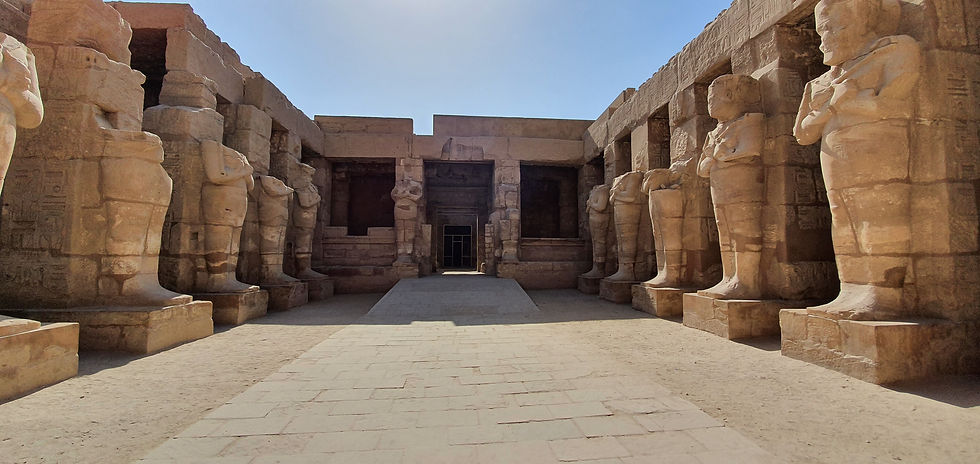
Entrance Fees:
Locals: [To be updated]
Foreigners: [To be updated]
*Foreign spouses of Egyptian nationals can avail the local rate by presenting their authenticated marriage certificate.
Luxor Museum

Luxor Museum Exterior by day — we visited it at night (Link: Isida Project)
Have you ever been to a museum and seen some display pieces lying around seemingly forgotten and unaccounted for?
Well, not at the Luxor Museum.

The gallery on the second floor — the photos I took inside do not do this place justice (Source: Nile Cruise Egypt)
Our AirBnB host-slash-guide had dismissed it as a place “not really worth seeing,” but I was really glad we visited it anyway.
The museum houses a “small” but fine collection of artifacts uncovered in Luxor itself, from statues and weapons to jewelry and 2 royal mummies: King Ahmose (left image below) and an unidentified Pharaoh (right image below).
Each display piece is carefully placed and well-lit, complete with descriptions that would give tour guides a run for their money.
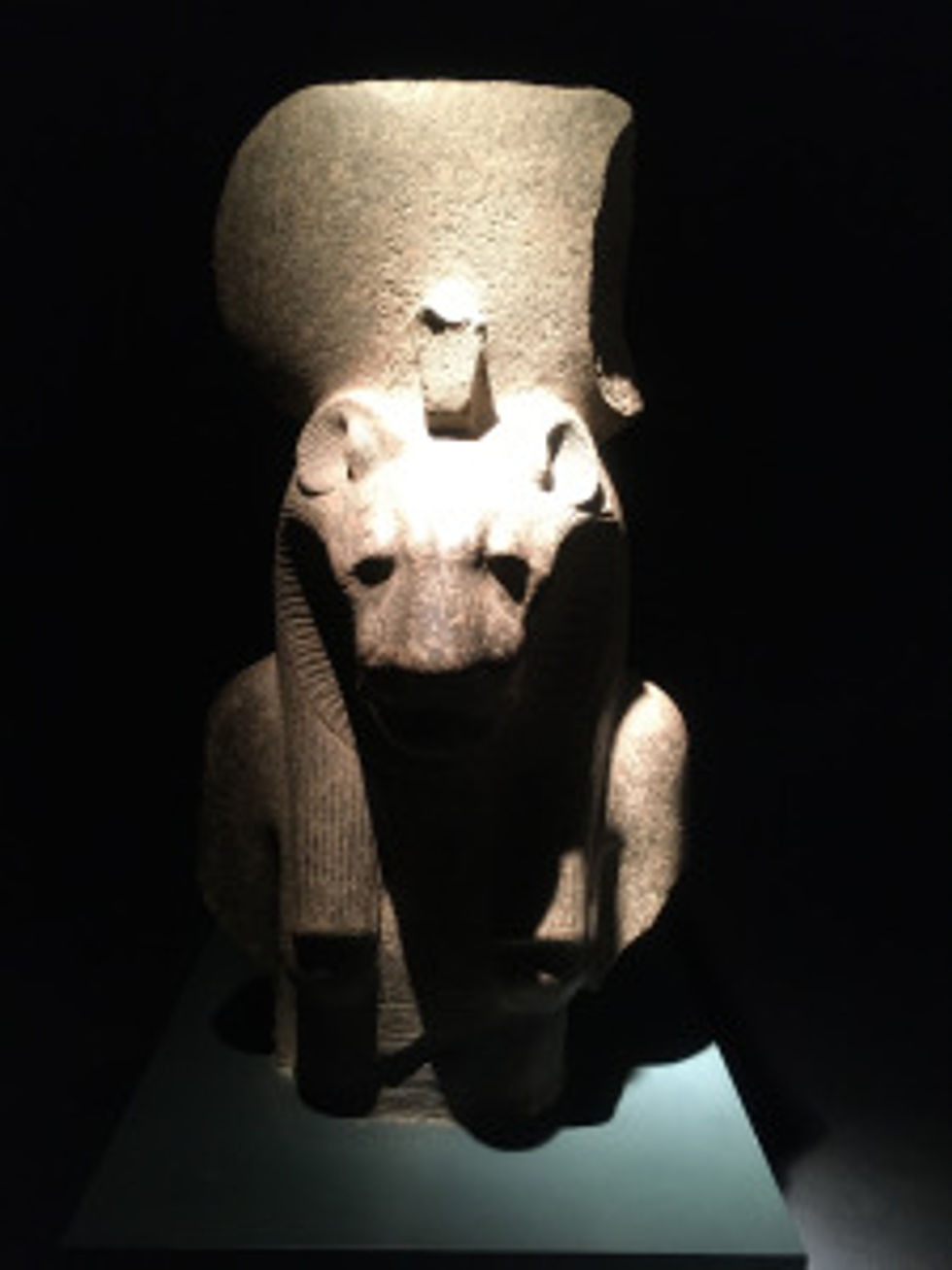
Sekhmet, the Ancient Goddess of War
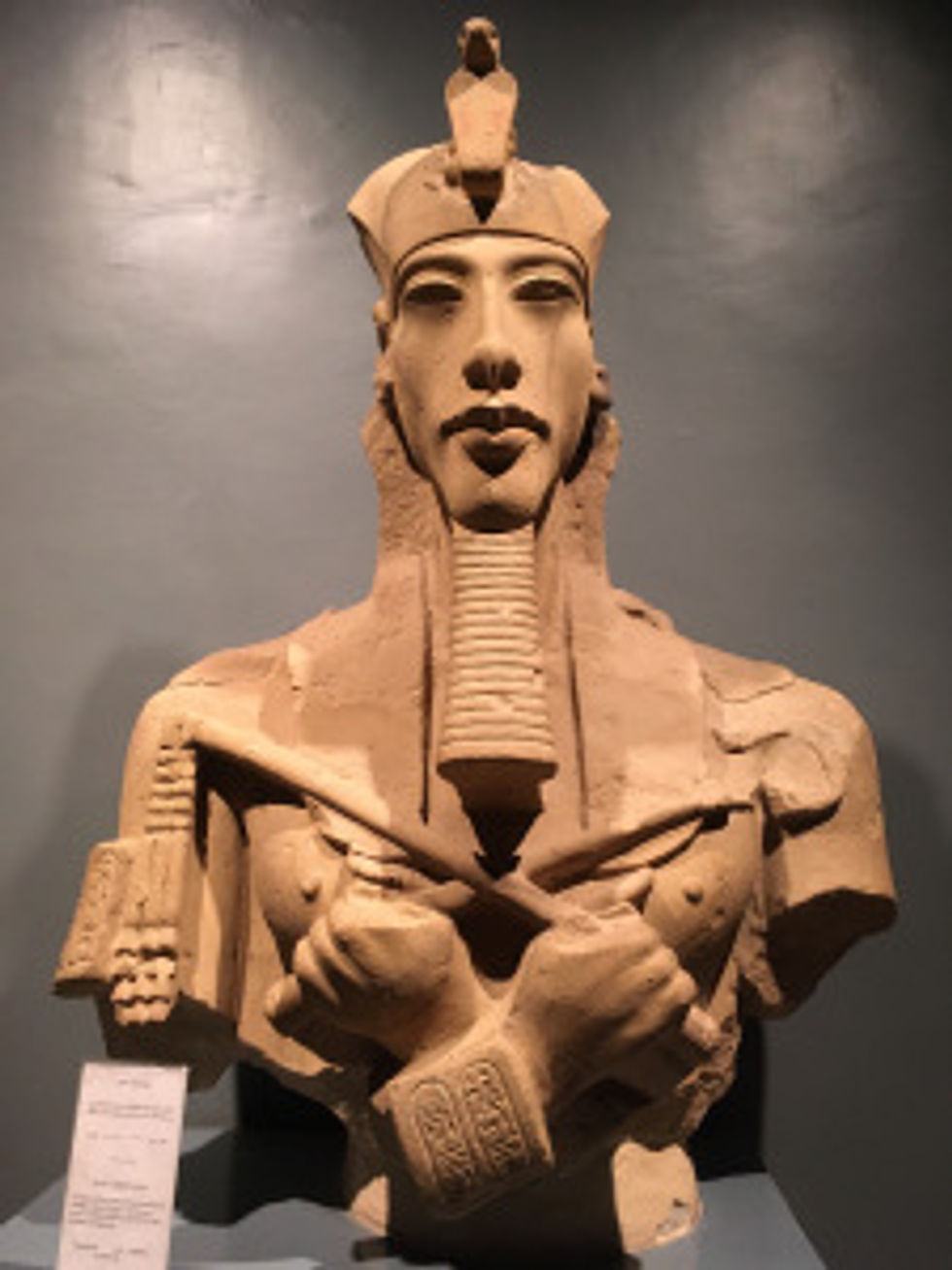
King Akhenaton (hey y’all, jaw line check)
Not to be overlooked is the New Hall.

Its entrance is hiding in plain sight, just to the right of the main entrance.
Once you go through the narrow, whitewashed passageway, you’ll find yourself surrounded by life-size statues of gods and kings, discovered as late as 1989 during an excavation in Luxor Temple.

Amun and Mut, the revered deities of the Ancient Theban Cult
Entrance Fees:
Locals: [To be updated]
Foreigners: [To be updated]
*Foreign spouses of Egyptian nationals can avail the local rate by presenting their authenticated marriage certificate.
Luxor Temple
By day, the outer walls of Luxor Temple stand in sharp contrast against its 21st century surroundings.
A mere “pile of rocks” in the middle of Downtown Luxor, where souvenir shops, hantoor (horse-drawn carriages) and fast food chains abound.
But by night, when the ancient walls are bathed in lights adding a curious air of mystery, Luxor Temple once again takes center stage.

Where Karnak Temple is wide and sprawling, Luxor Temple is long and narrow.
Amazingly, the two temples (which are quite a distance away from each other) are connected by an avenue of sphinxes (but was closed when we went there).
Luxor Temple was once dedicated to the Theban Triad: Amun-Ra, his consort Mut and their son Khonsu.

Amun-Ra and Mut
In ancient times, Amun-Ra’s statue in Karnak Temple used to be carried in a grand procession once a year to be united with his wife in Luxor Temple.

Inside the heart of the temple, the Holy of Holies
Today, Luxor Temple’s central location makes it an ideal place for locals, not just tourists, to hang out too.
Entrance Fees:
Locals: [To be updated]
Foreigners: [To be updated]
*Foreign spouses of Egyptian nationals can avail the local rate by presenting their authenticated marriage certificate.
Day 2: Valley of the Kings and Temple of Hatshepsut
Valley of the Kings
Our first stop on our second day in Luxor was the famed Valley of the Kings.
Located on the West Bank, it was just a few minutes’ drive from the AirBnB we were staying at.
I was initially concerned about the crowd of tourists already gathered there at 10 a.m., but once inside, I realized that there were more than enough tombs for us to explore without feeling claustrophobic.
Of the 63 known tombs in the Valley today, only a few are open to the public at one time, as a rotation system has been introduced to protect the tomb walls from further deteriorating (from tourist perspiration of all things!).

Even from the security check, the friendly security guys already gave us recommendations on which tombs to explore (labelled KV 1, 2, 3 and so on).
And since our combined knowledge of Ancient Egypt didn’t add up to much, my husband and I decided to go with their Top 3 recommendations.

A regular entrance ticket gives you access to 3 tombs of your choice (so long as they are open on the day of your visit).
Some tombs have additional entrance fees, Tutankhamun’s included, but I still thought it was something that shouldn’t be missed (despite it now being emptied of its famous treasures).
When you pay for your tickets, there’s also an option to pay a minimal fee for a wagon transport — take it!
You’ll need all that energy to walk from tomb to tomb (that sounded morbid), so you’re better off reserving energy on the wagon trip where you can sit, relax and take in the view of pink limestone mountains left and right.

Spotted: Egyptologists in their natural habitat
The wagon can only take you as far as the main gates to the Valley.
From there, another security check, before you’re forced to surrender professional photography devices (including GoPros).

If you’re friendly to the security guys at the main gate, they’ll be happy to draw you a rough sketch of the tombs you want to visit at the back of your ticket.
Speaking of tickets, keep it handy, because you’ll be asked to present it at each tomb entrance, where a watchman punches a hole.
Inside the tombs, you’re either free to run up and down the planks (if they’re empty) or be herded by tourists on both directions.
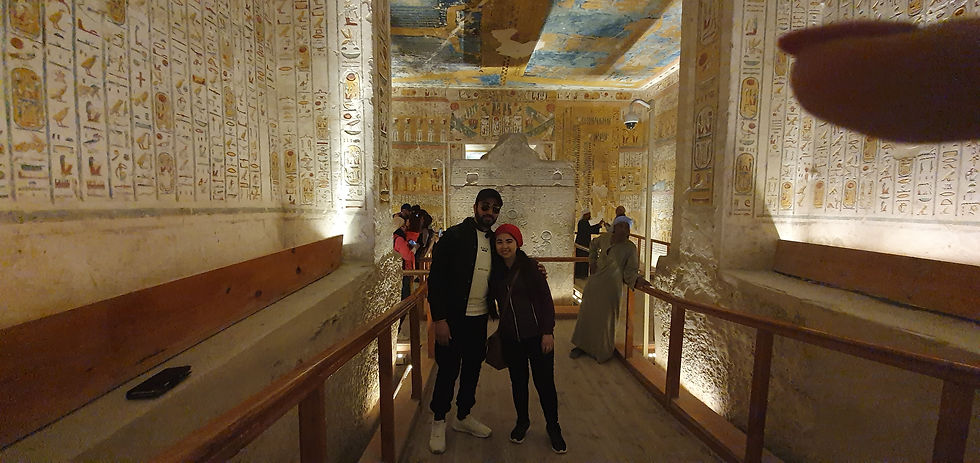
Mind the perfectly manicured finger! We met a lovely tourist from Greece who offered to take one of our few couple shots at the Valley (we didn’t even need to ask!)
Where there are tourists, there are always locals looking for ways to make a living (like the man clad in traditional jalabiya on the background).
They’re excellent historians (and photographers too!) — just don’t expect them to offer their services for free ! So it’s better to ask a fellow tourist to take your photos instead of hiring a “professional”.
The further you go underground (and some tombs stretch quite a long way), the cooler the air gets.

Trying my best to smile and not get freaked out by the broken sarcophagus of a possibly escaped living mummy here
Most of the tombs had already long been looted or else their contents were transported to museums around the world, so they felt “empty”, save for the surviving paintings on the walls.
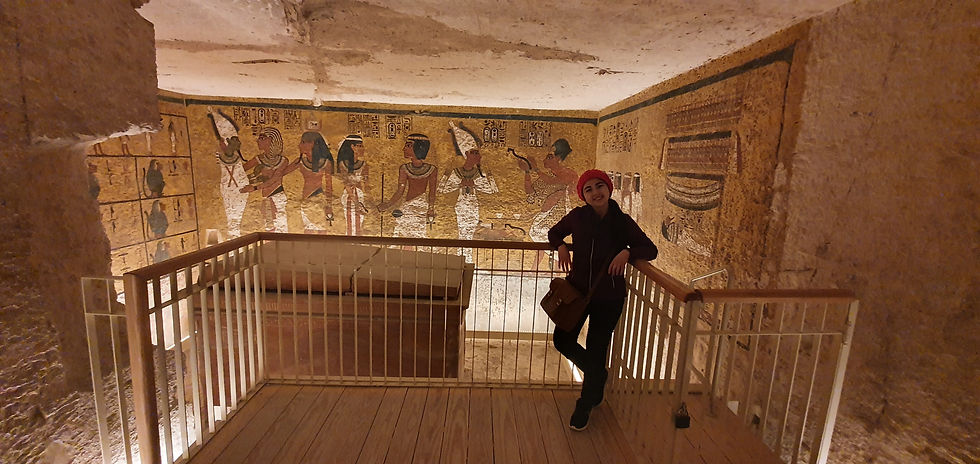
Inside the reportedly cursed Tomb of Tutankhamun
But some felt a little strange, made you think if all those talk of ancient curses had some grain of truth in them.
Inside one of the tombs we visited, there was a tunnel that was fenced, supposedly because the tomb construction was supposedly never finished.
But as to what lies beneath is shrouded with mystery.
You can see it behind the sarcophagus on the left photo above.
I couldn’t even stand in front of it for a full minute, because it gave me the heebie-jeebies.
One of the tombs we visited was none other than the Boy King Tutankhamun’s.

Even though I had high hopes for his tomb, it appeared relatively less grand than the other tombs we visited, but perhaps it was only because there was very limited space opened to the public.

Still, it was worth seeing King Tut in the flesh.

After a 3-hour tour of just 5 out of 63 tombs in the Valley, we were ready to call it a day, but there was still one more stop on the day’s itinerary.
Entrance Fees:
Locals: [To be updated]
Foreigners: [To be updated]
*Foreign spouses of Egyptian nationals can avail the local rate by presenting their authenticated marriage certificate.
Temple of Hatshepsut

I remember learning about Hatshepsut in high school.
You don’t find many examples of outstanding female rulers back in her day, so the image of a powerful Pharaoh (and not merely Queen) stayed with me right up to the day I was finally able to visit her mummy at the Cairo Museum.
She looked smaller and frailer than I imagined.
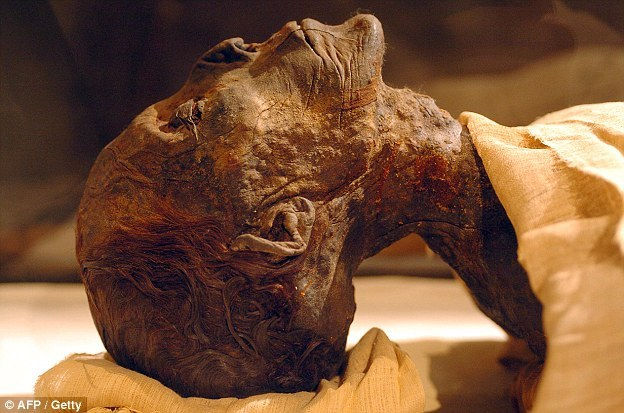
So nothing prepared me for her monumental temple a few minutes’ drive away from the Valley of the Kings.

Set in a spectacular natural ampitheater, the Temple of Hatshepsut was truly fit for a King in life.
But apparently not in death, because Egyptologists located her mummy elsewhere in the Valley of the Kings.
The temple complex is a long way away from the ticket counter, so again purchasing a wagon ticket is recommended.

Save some energy for all the mandatory stair climbing to get to the top.

While the design itself is spectacular, it’s the temple’s architecture (partially hollowed out of rocks) that makes it truly a natural and man-made masterpiece.

Entrance Fees:
Locals: [To be updated]
Foreigners: [To be updated]
*Foreign spouses of Egyptian nationals can avail the local rate by presenting their authenticated marriage certificate.
We ended our tour of Luxor by watching the sunset on the Nile River.


















Comments